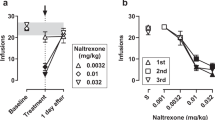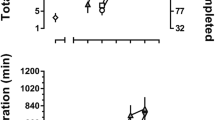Abstract
Rationale
Drugs of abuse can affect the functioning of the hypothalamic–pituitary–adrenal (HPA) axis. Acute administration of drugs that serve as reinforcers have been observed to stimulate the rat HPA axis, leading to the suggestion that these stimulatory effects may contribute to the development of drug-maintained behaviors.
Objectives
To determine whether reinforcing drugs that are dissimilar with respect to their mechanisms of action have similar effects on HPA axis activity at doses that are self-administered. Rhesus monkeys were randomly assigned to self-administer the μ-opioid agonist fentanyl, the psychomotor stimulant cocaine, or the NMDA antagonist ketamine.
Methods
Each monkey was trained to press a lever in order to receive an intravenous injection of drug or saline. Blood samples were obtained before, during, and after the self-administration sessions and assayed for ACTH and cortisol by radioimmunoassay.
Results
Fentanyl, cocaine, and ketamine were each self-administered across a range of doses. However, the three drugs differed in their effects on ACTH and cortisol. Cocaine stimulated ACTH and cortisol secretion, a finding that is consistent with previous rat and primate studies. Self-administration of both fentanyl and ketamine inhibited HPA axis activity. HPA inhibition by fentanyl is consistent with other monkey and human studies, and contrasts with the stimulatory effects of μ-opioids in rodents. The inhibitory effect of ketamine on ACTH and cortisol secretion contrasts with findings in the few primate studies that have evaluated NMDA antagonists. Neither fentanyl nor cocaine, at doses that maintained maximum rates of responding, produced significant changes in ACTH and cortisol levels.
Conclusions
There appears to be little commonality between different classes of abused drugs and their effects on the HPA axis, which calls into question the necessity for HPA axis stimulation in the reinforcement of drug-maintained behavior.



Similar content being viewed by others
References
Adams H, Thiel A, Jung A, Fengler G, Hempelmann G (1992) Studies using S-(+)-ketamine on probands. Endocrine and circulatory reactions, recovery and dream experiences. Anaesthesist 41:588–596
Allolio B, Deuss U, Kaulen D, Leonhardt U, Kallabis D, Hamel E, Winkelmann W (1986) FK 33-824, a met-enkephalin analog, blocks corticotropin-releasing hormone-induced adrenocorticotropin secretion in normal subjects but not in patients with Cushing’s disease. J Clin Endocrinol Metab 63:1427–1431
Allolio B, Schulte H, Deuss U, Kallabis D, Hamel E, Winkelman W (1987) Effect of oral morphine and naloxone on pituitary–adrenal response in man induced by human corticotropin-releasing hormone. Acta Endocrinol 114:509–514
Broadbear JH, Winger G, Cicero T, Woods JH (1999a) The effects of self administered cocaine on plasma ACTH and cortisol in male rhesus monkeys. J Pharmacol Exp Ther 289:1641–1647
Broadbear JH, Winger G, Woods JH (1999b) Cocaine responding in rhesus monkeys: pharmacological antagonism of the HPA effect. J Pharmacol Exp Ther 290:1347–1355
Calogero AE, Gallucci WT, Kling MA, Chrousos GP, Gold PS (1989) Cocaine stimulates rat hypothalamic corticotropin-releasing hormone secretion in vitro. Brain Res 505:7–11
Delitala G, Brossman A, Besser M (1983) Differential effects of opiate peptides and alkaloids on anterior pituitary hormone secretion. Neuroendocrinology 37:275–279
Elvidge H, Challis J, Robinson J, Roper C, Thorburn G (1976) Influence of handling and sedation on plasma cortisol in rhesus monkeys (Macaca mulatta). J Endocrinol 70:325–326
Farah J, Rao T, Mick S, Coyne K, Iyengar S (1991) N-Methyl-d-aspartate treatment increases circulating adrenocorticotropin and luteinizing hormone in the rat. Endocrinology 128:1875–1880
Gaillard R, Grossman A, Smith R, Rees L, Besser G (1981) The effects of a met-enkephalin analogue on ACTH, β-LPH, β-endorphin and met-enkephalin in patients with adrenocortical disease. Clin Endocrinol 14:471–478
Galici R, Pechnick RN, Poland R, France CP (2000) Comparison of noncontingent versus contingent cocaine administration on plasma corticosterone levels in rats. Eur J Pharmacol 387:59–62
Garland E, Zis A (1989) Effect of codeine and oxazepam on afternoon cortisol secretion in men. Psychoneuroendocrinology 14:397–402
Garland E, Zis A (1990) Effect of vasopressin and naloxone alone and in combination on cortisol secretion after dexamethasone pretreatment. Horm Res 34:249–253
Gay V, Plant T (1987) N-methyl-d,l-aspartate elicits hypothalamic gonadotropin-releasing hormone release in prepubertal male rhesus monkeys (Macaca mulatta). Endocrinology 120:2289–2296
Goeders N, Guerin G (1994) Non-contingent electric footshock facilitates the acquisition of intravenous cocaine self-administration in rats. Psychopharmacology 114:63–70
Goeders N, Guerin G (1996) Effects of surgical and pharmacological adrenalectomy on the initiation and maintenance of intravenous cocaine self-administration in rats. Brain Res 722:145–152
Goeders N, Guerin G (2000) Effects of the CRH receptor antagonist, CP-154,526 on intravenous cocaine self-administration in rats. Neuropsychopharmacology 23:577–586
Hayes A, Stewart B (1985) Effect of μ and κ opioid receptor agonists on rat plasma corticosterone levels. Eur J Pharmacol 116:75–79
Heesch C, Negus B, Keffer J, Snyder R, Risser R, Eichhorn E (1995) Effects of cocaine on cortisol secretion in humans. Am J Med Sci 310:61–64
Hotta M, Shibasaki T, Yamauchi N (1991) The effects of chronic central administration of corticotropin-releasing factor on food intake, body weight, and hypothalamic–pituitary–adrenocortical hormones. Life Sci 48:1483–1491
Iyengar S, Mick S, Dilworth V, Michel J, Rao T, Farah J, Wood P (1990) Sigma receptors modulate the hypothalamic–pituitary–adrenal (HPA) axis centrally: evidence for a functional interaction with NMDA receptors, in vivo. Neuropharmacology 29:299–303
Jezova D, Oliver C, Jurcovicova J (1991) Stimulation of adrenocorticotropin but not prolactin and catecholamine release by N-methyl-aspartic acid. Neuroendocrinology 54:488–492
Koek W, Colpaert FC, Woods JH, Kamenka JM (1989) The phencyclidine (PCP) analog N-[1-(2-benzo(B)thiophenyl) cyclohexyl]piperidine shares cocaine-like but not other characteristic behavioral effects with PCP, ketamine and MK-801. J Pharmacol Exp Ther 250:1019–1027
Lu L, Liu Z, Huang M, Zhang Z (2003) Dopamine-dependent responses to cocaine depend on corticotropin-releasing factor receptor subtypes. J Neurochem 84:1378–1386
Mendelson J, Mello N, Teoh S, Ellingboe J, Conchin J (1989) Cocaine effects on pulsatile secretion of anterior pituitary, gonadal, and adrenal hormones. J Clin Endocrinol Metab 69:1256–1260
Moldow R, Fischman A (1987) Cocaine-induced secretion of ACTH, beta-endorphin, and corticosterone. Peptides 8:819–822
Nader M, Barrett J (1989) Effects of corticotropin-releasing factor (CRF), tuftsin and dermophin on behavior of squirrel monkeys maintained by different events. Peptides 10:1199–1204
Pechnick RN (1993) Effects of opioids on the hypothalamo–pituitary–adrenal axis. Annu Rev Pharmacol Toxicol 32:353–382
Piazza P, le Moal M (1996) Pathophysiological basis of vulnerability to drug abuse: role of an interaction between stress, glucocorticoids, and dopaminergic neurons. Annu Rev Pharmacol Toxicol 36:359–378
Piazza P, Maccari S, Deminiere J, le Moal M, Mormede P, Simon H (1991) Corticosterone levels determine individual vulnerability to amphetamine self-administration. Proc Natl Acad Sci USA 88:2088–2092
Reyes A, Luckhaus J, Ferin M (1990) Unexpected inhibitory action of N-methyl-d,l-aspartate on luteinizing hormone release in adult avariectomized rhesus monkeys: a role for the hypothalamic–adrenal axis. Endocrinology 127:724–729
Rittmaster R, Cutler G, Sobel D, Goldstein D, Koppelman M, Loriaux D, Chrousos G (1985) Morphine inhibits the pituitary–adrenal response to ovine corticotropin-releasing hormone in normal subjects. J Clin Endocrinol Metab 60:891–895
Rivier C, Vale W (1987) Cocaine stimulates adrenocorticotropin (ACTH) secretion through a corticotropin-releasing factor (CRF)-mediated mechanism. Brain Res 422:403–406
Sarnyai Z, Shaham Y, Heinrichs S (2001) The role of corticotropin-releasing factor in drug addiction. Pharmacol Rev 53:209–243
Setchell K, Shackleton C, Himsworth R (1975) Studies on plasma corticosteroids in the rhesus monkey (Macaca mulatta). J Endocrinol 67:241–250
Shaham Y, Stewart J (1994) Exposure to mild stress enhances the reinforcing efficacy of intravenous heroin self-administration in rats. Psychopharmacology 114:523–527
Shaham Y, Erb S, Leung S, Buczek Y, Stewart J (1998) CP-154,526, a selective, non-peptide antagonist of the corticotropin-releasing factor 1 receptor attenuates stress-induced relapse to drug seeking in cocaine- and heroin-trained rats. Psychopharmacology 137:184–190
Tallarida RJ, Murray RB (1987) Manual or pharmacologic calculations with computer programs. Springer-Verlag, New York
Vescovi P, Coiro V, Volpi R, Giannini A, Passeri M (1992) Diurnal variations in plasma ACTH, cortisol and beta-endorphin levels in cocaine addicts. Horm Res 37:221–224
Ward A, Collins E, Haney M, Foltin R, Fischman M (1998) Ketoconazole attenuates the cortisol response but not the subjective effects of smoked cocaine in humans. Behav Pharmacol 9:577–586
Acknowledgements
This work was supported by the United States Public Health Service Grants DA 09161 and DA 00254. The authors wish to thank Nicholas Jones, Deborah Huntzinger, Sarah Pilkington and Laurie McDowell for their expert technical assistance. Animals used in these studies were maintained in accordance with the “Principles of laboratory animal care” (http://www.nap.edu/readingroom/books/labrats/), and all studies reported here were carried out in consultation with the University of Michigan Committee on Animal Care and Guidelines of the Committee on the Care and Use of Laboratory Animal Resources, National Health Council (Department of Health, Education and Welfare, ISBN 0-309-05377-3, revised 1996).
Author information
Authors and Affiliations
Corresponding author
Rights and permissions
About this article
Cite this article
Broadbear, J.H., Winger, G. & Woods, J.H. Self-administration of fentanyl, cocaine and ketamine: effects on the pituitary–adrenal axis in rhesus monkeys. Psychopharmacology 176, 398–406 (2004). https://doi.org/10.1007/s00213-004-1891-x
Received:
Accepted:
Published:
Issue Date:
DOI: https://doi.org/10.1007/s00213-004-1891-x




